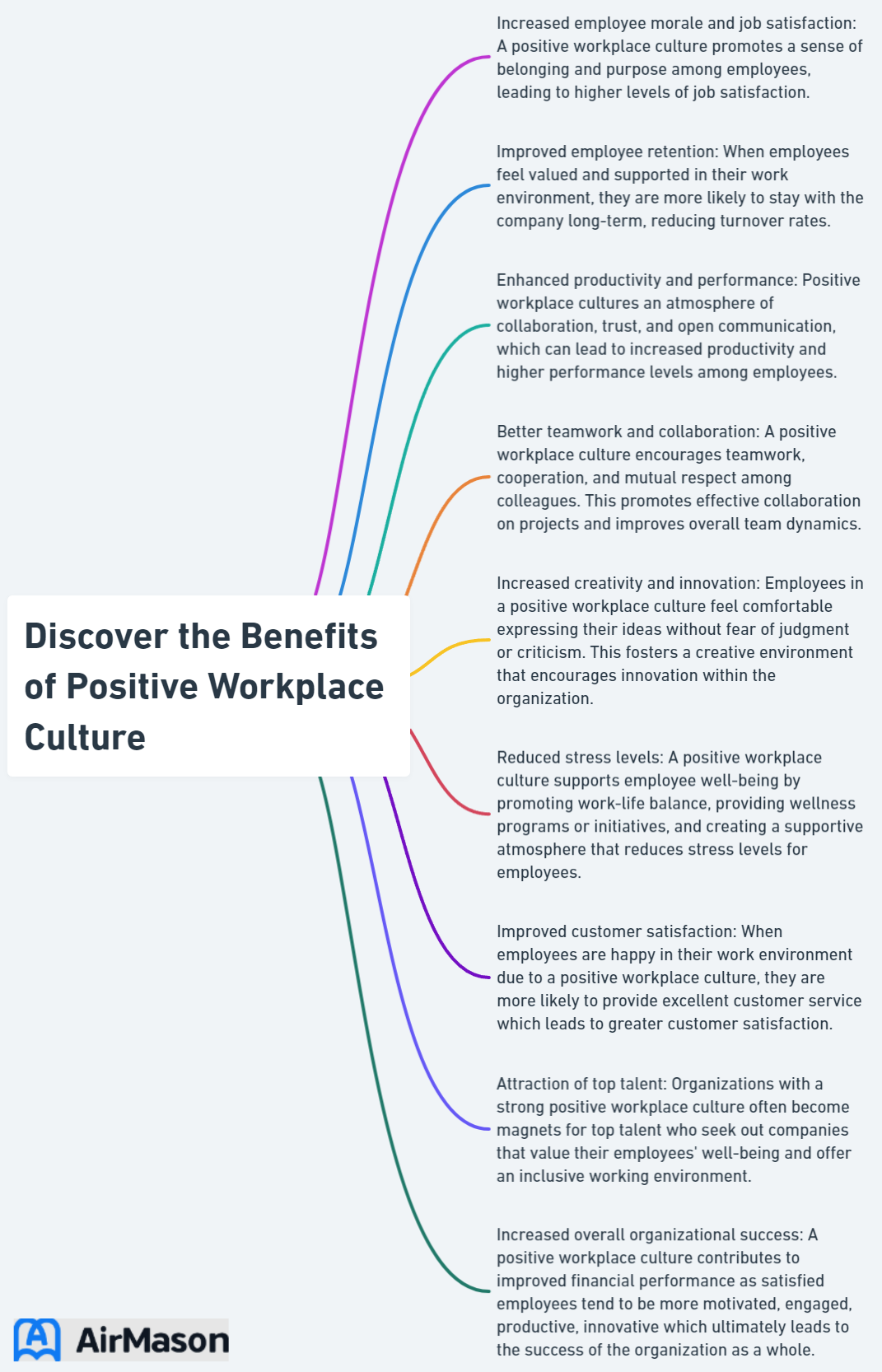
A positive workplace culture can work wonders for any organization, fostering increased productivity, employee happiness, and business success. But what exactly constitutes a positive culture, and how can businesses cultivate the benefits of positive workplace culture? In this blog post, we’ll explore the various aspects of a thriving workplace environment and provide actionable strategies for creating a positive atmosphere that benefits everyone involved.
Key Takeaways
- Positive workplace culture boosts business performance, productivity and customer satisfaction.
- A positive attitude in the workplace encourages collaboration, creativity and trust.
- Strategies such as open communication, inspirational leadership & employee recognition can create a healthy work environment with increased job satisfaction & wellbeing.
The Impact of Positive Workplace Culture on Business Performance
A healthy and supportive work environment is the cornerstone of a thriving business. A positive work culture in an organization focuses on uplifting work practices that foster increased performance, creating a positive environment for employees. Some of the wonderful characteristics of a healthy culture are:
- Support
- Trust
- Accountability
- An overall healthy work culture that encourages positive thinking.
We will now examine how a positive workplace culture can influence business performance.

Enhanced Productivity
A positive work environment significantly boosts productivity by fostering positive emotions and well-being, resulting in higher work output and commitment levels. Studies have shown that a positive work environment can boost productivity by 12%, while a negative work environment can hinder productivity, resulting in lost revenue and decreased employee satisfaction.
A positive work culture can be cultivated by:
- Nurturing social connections
- Strengthening teamwork
- Elevating morale
- Augmenting efficiency
- Improving employee retention
This creates a virtuous cycle of success, where employees are motivated to perform at their best, ultimately leading to a successful workplace.
Better Employee Engagement
Promoting a healthy workplace can create a sense of loyalty, comfort, and trust among team members, resulting in increased employee engagement. Engaged employees can potentially bring in up to $550 billion a year in the U.S. alone. High levels of employee engagement lead to increased productivity and performance, a positive workplace culture, innovation and creativity, employee retention and loyalty, and improved customer satisfaction.
Employee engagement is a critical factor in driving employee performance and overall business success. Engaged workforces enjoy higher earnings per share, extraordinary total returns to shareholders, and outstanding levels of customer satisfaction.
Increased Customer Satisfaction
A strong company culture builds a powerful brand identity, leading to increased customer satisfaction and loyalty. Companies like:
- Apple
- Zappos
- Ritz-Carlton
- Disney
- Amazon
are shining examples of organizations with strong cultures that have high customer satisfaction. There is a direct link between employee satisfaction and customer satisfaction, with happy employees leading to happy customers.
A positive workplace culture can significantly enhance customer service by:
- Fostering happier, more engaged, and motivated employees
- Leading to improved customer interactions
- Better problem-solving
- Increased customer satisfaction
An Organization’s Culture
An organization’s culture is the heartbeat of its identity, representing the collective values, beliefs, and behaviors that shape its work environment. It serves as the guiding force, influencing how employees interact, collaborate, and approach their tasks. A strong organizational culture fosters a sense of belonging and unity among team members, aligning them towards common goals and objectives. It sets the tone for decision-making, from the highest levels of leadership to the front lines of operations. Moreover, an organization’s culture can be a powerful tool in attracting and retaining talent, as individuals are drawn to environments that resonate with their own values and aspirations. In essence, an organization’s culture is a dynamic force that not only defines its character but also plays a crucial role in its success and sustainability in today’s competitive landscape.
The Role of Positive Attitude in the Workplace

A positive attitude in the workplace is essential for fostering an organization with highly motivated and content employees who feel appreciated. Positive organizational psychology demonstrates that having a positive attitude can foster a culture of:
- taking initiative
- proactivity
- ownership
- growth opportunities
This can lead to increased productivity and success.
The subsequent subsections will delve into how a positive attitude can stimulate collaboration and teamwork, inspire innovation and creativity, and establish trust and support among employees.
Promotes Collaboration and Teamwork

Collaboration is fostered in a positive work environment that motivates and supports employees, and promotes teamwork. Effective collaboration within company departments boosts employee engagement and productivity. The benefits of teamwork in a positive work environment include:
- Effective communication
- Improved problem-solving
- Increased productivity
- Enhanced creativity
- A supportive work environment
A positive atmosphere encourages employees to work together towards common goals, ultimately leading to a more successful workplace.
Encourages Innovation and Creativity
Creativity and innovation flourish in a positive workplace, as employees feel encouraged to take risks and explore new ideas. A positive workplace culture promotes an atmosphere that:
- Celebrates and encourages new ideas
- Fosters open communication and collaboration
- Offers support and resources
- Recognizes and rewards creativity
- Cultivates a sense of psychological safety
When employees feel positive and supported in their work environment, they are more likely to take risks and try new ideas, leading to an increase in innovation, creativity, and overall performance. Companies like Patagonia, Google, Virgin, HubSpot, and Dyson are inspiring examples of innovative businesses driven by positive workplace cultures.
Builds Trust and Support
A positive attitude can foster an atmosphere of trust and understanding among coworkers and management. When employees feel secure in their relationships with each other, they are more likely to be open to feedback, creating a positive work culture where everyone feels encouraged to share their thoughts and ideas. By adopting a positive mindset, employees can further enhance this collaborative environment.
Trust is paramount for successful teamwork and collaboration, and employees who possess a positive outlook are more likely to be dependable and trustworthy team members to others.
How to Build a Strong Company Culture
Creating a robust company culture is vital for fostering a positive work environment and driving organizational success. To understand how to build a strong company culture, it’s essential to start with a clear vision and values that align with the company’s mission. This foundation provides a roadmap for behavior and decision-making across all levels of the organization. Communication plays a pivotal role; leaders must consistently and transparently communicate these values and expectations to every member of the team. Moreover, encouraging employee participation in shaping the culture through feedback mechanisms and collaborative initiatives empowers them to take ownership of their work environment. Additionally, recognizing and rewarding behaviors that exemplify the desired culture reinforces its importance and sets the standard for all employees. Finally, fostering inclusivity and diversity within the workplace ensures that the culture is both representative and supportive of all team members, driving innovation and adaptability.
How a Healthy Work-Life Balance Contributes to a Positive Culture

A healthy work-life balance enhances a positive workplace culture by reducing stress, promoting wellbeing, and increasing job satisfaction. The ensuing subsections will analyze how a good work life balance can augment a positive culture by relieving workplace stress, enhancing employee wellbeing, and increasing job satisfaction.
Reduces Workplace Stress
Managing workplace stress effectively leads to a more positive and productive work environment. The American Psychological Association recently estimated that workplace stress is costing the U.S. economy more than $500 billion annually. Strategies to reduce anxiety and tension in the workplace could result in a substantial increase in productivity..
Open and honest communication, inspirational leadership, and employee recognition and rewards can all be effective strategies for managing workplace stress, resulting in a happier, more successful workplace.
Improves Employee Wellbeing
Employee wellbeing is supported in a positive workplace, promoting overall health and happiness. A positive workplace has direct benefits on employee mental health, including:
- Improved job performance and productivity
- Increased work engagement and innovation
- Reduced stress and anxiety levels
- Enhanced overall well-being and life satisfaction
- Better work-life balance
- Higher job satisfaction and retention rates.
When businesses place employee wellbeing as a priority, they reap the benefits of a workforce that is more motivated and engaged, which in turn heightens productivity and success.
Boosts Job Satisfaction
A healthy work-life balance can significantly enhance job satisfaction by providing individuals with time to engage in activities and relationships outside of work. Job satisfaction has immense impact on overall business performance, leading to:
- Improved productivity
- Customer loyalty
- Employee engagement
- Higher retention rates
- Better mental and physical health
Creating a positive work environment and giving priority to employee satisfaction allows businesses to reap the rewards of a prosperous and flourishing workplace.
Strategies for Fostering a Positive Company Culture

To create a positive workplace culture, organizations can implement strategies such as open and honest communication, inspirational leadership, and employee recognition and rewards.
The upcoming subsections will delve into these strategies in detail and analyze their role in shaping a positive company culture.
Open and Honest Communication
Encouraging open and honest communication helps create a transparent and supportive work environment. The advantages of open and honest communication in the workplace include:
- Enhanced engagement
- Higher productivity
- Instilling accountability
- Creating a sense of purpose
- Elevating employee morale and satisfaction.
By promoting open communication and making sure employees feel acknowledged and appreciated, businesses can create a positive work environment where everyone is driven to succeed.
Inspirational Leadership
The role of inspirational leadership is pivotal in fostering a positive workplace culture and engaging employees. Inspirational leaders:
- Take a genuine interest in their team members
- Attentively listen to their needs
- Offer support during difficult times
- Lead by example, embodying behaviors that reflect their values
- Encourage others to do the same
Inspirational leadership fosters personal and collective growth, resulting in energized and enthusiastic employees who are motivated to perform at their best.
Employee Recognition and Rewards
Acknowledging and rewarding employees for their accomplishments and efforts instills a sense of appreciation and motivation. Tailoring recognition and rewards to individual employees demonstrates that their efforts are valued and recognized, which can help to motivate and engage them.
Moreover, personalized recognition and rewards can create a positive and inclusive work environment, where employees feel seen, heard, and valued for their individuality. This can lead to enhanced job satisfaction, productivity, and retention.
Hard Working Culture: Fostering Productivity and Growth
A hard working culture is the cornerstone of any successful organization, permeating through every level and department. This ethos is more than just a collection of dedicated individuals; it’s a collective mindset that drives productivity and propels a company toward its goals. In a workplace where a hard working culture is cultivated, employees are inspired to go above and beyond, setting new benchmarks for excellence. This culture is not about working longer hours, but about working smarter, prioritizing tasks, and constantly seeking ways to improve processes. It encourages a proactive approach to challenges, where every setback is seen as an opportunity to learn and grow. When a hard working culture becomes ingrained in the DNA of a company, it fosters an environment where innovation thrives and accomplishments become a shared success story.
Summary
In conclusion, a positive workplace culture brings numerous benefits to both employees and businesses, including enhanced productivity, employee engagement, and customer satisfaction. By fostering a positive attitude, promoting a healthy work-life balance, and implementing effective strategies such as open communication, inspirational leadership, and employee recognition, organizations can create a thriving, successful workplace where everyone feels motivated to excel.
Frequently Asked Questions
What are the benefits of a positive company culture?
Having a positive company culture has numerous benefits, such as fueling creativity, reducing employee burnout, attracting top talent, fostering innovation and generating a sense of belonging. This will ultimately lead to increased productivity, improved wellbeing, better customer satisfaction, a stronger brand identity and better employee retention.
Why is positive culture important in the workplace?
Having a positive work culture fosters teamwork, boosts morale, increases productivity, and reduces stress, while also leading to better job performance, reduced turnover, increased loyalty and better customer service. All of these benefits can be realized when there is a supportive atmosphere that encourages employees to give their best.
What are two benefits of positive values?
Having positive values can help young people make responsible choices, think independently, and lead happier lives. Additionally, it encourages them to take responsibility for their actions and make decisions based on their own judgement rather than trends.
What factors contribute to a positive workplace culture?
Creating a positive workplace culture starts with fostering support, trust, accountability, and a sense of belonging among employees.
How does a positive work environment enhance productivity?
A positive work environment helps to motivate, focus and encourage goal-setting among employees, thereby enhancing productivity.